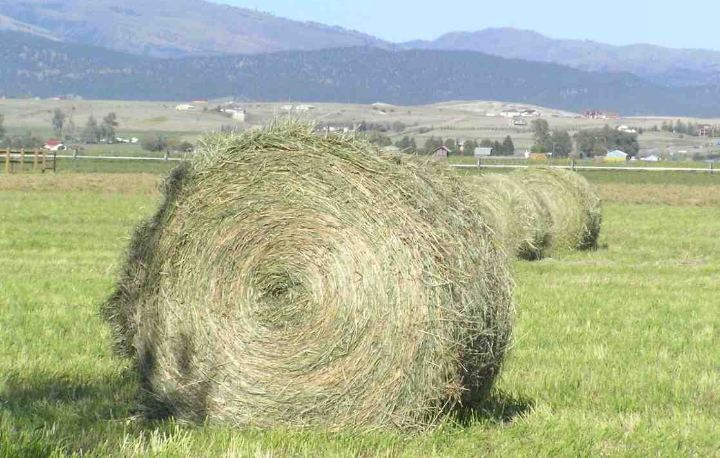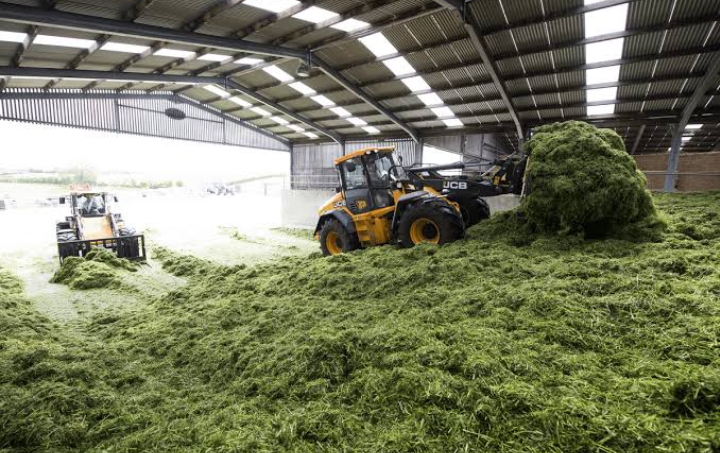Hay and Silage are two popular types of fodder used to feed livestock when fresh grazing is limited or unavailable particularly during winter or drought conditions. In this article, let us look at the major differences between of hay and silage based on production methods, nutritional profiles, storage requirements, advantages and disadvantages.
What is Hay?

Hay is a type of fodder that is primarily made from drying and preserving grasses, legumes or herbaceous plants. It serves as a valuable source of animal feed, particularly during periods when fresh grazing is limited or unavailable such as during winter or drought conditions.
The process of making hay involves mowing the field and allowing the cut plants to dry in the sun for a period of time and then baling them into compact bundles for transportation and storage. The drying process helps prevent the growth of mold or bacteria. Hay provides essential nutrients and dietary fiber to livestock such as horses, cattle, sheep and goats.
Hay can be fed to animals either by placing it in feeding troughs or by scattering it on the ground. Other than use as animal feed, hay can also be used in gardening and landscaping as a mulch.
Hay can be further classified into different types, including grass hay, legume hay, or mixed hay, based on the plant species present in the forage. The main objective of haymaking is to remove moisture from the plants to prevent spoilage and preserve their nutritional value.
What is Silage?

Silage is a type of fodder that is fermented and preserved through a process called ensiling. It is primarily used as a feed for livestock, especially ruminants such as cattle, sheep and goats. Silage is produced by packing green forage crops like grass corn or legumes, into a compact and airtight storage structure to undergo anaerobic fermentation.
The process of making silage begins with the harvesting of the forage crops at their optimal stage of growth. The crops are then chopped into small pieces and then immediately transferred to the storage structure to minimize exposure to air. In the storage structure, the forage is packed tightly to exclude as much air as possible so as to facilitate anaerobic fermentation process.
The fermentation process converts the plant sugars into organic acids and help to build an acidic environment that inhibits the growth of harmful bacteria. The result is a highly nutritious feed that retains much of its original nutritional value.
The common methods used to store silages are silos, pits, trenches, bunkers, silage bags and silage bales. Silos and bunkers are used when there are large quantities present, whilst bags and bales are often used when there are only small quantities to be stored.
Silage is highly nutritious and can retain a significant portion of the original nutrients present in the forage crop. It can be a reliable source of feed throughout periods of hash weather.
Key Difference
- Moisture content: Hay is dried forage containing moisture levels between 15% and 20%. Silage has higher moisture content between 40% to 70%.
- Preservation method: Hay is preserved through the process of drying, either by sun-curing or mechanical drying. In other words, hay is mowed, dried and stored in bales. Silage is preserved through fermentation under anaerobic conditions. In other words, silage is compacted and stored in pits or air-tight conditions without being dried.
- Harvesting stage: Hay is harvested when the forage has reached its maximum nutritional value and is fully mature. Silage, on the other hand, is often harvested at a slightly earlier stage of maturity to optimize moisture content for fermentation.
- Enzyme: No enzyme or chemical is added during preparation of hay. A bacterial enzyme is added after chopping the plant material.
- Nutritional quality: Hay generally has a lower nutritional value compared to silage even though it retains more of the original nutrients from the forage. Significant percentage of nutrients is lost during the drying process. Silage undergoes fermentation, which can cause some nutrient losses, particularly the vitamins. But overall, it has higher nutrient density to hay.
- Digestibility: Hay is less digestible than silage due to the drying process. Silage contains higher levels of fermentable carbohydrates and is partially or easily digested by animals.
- Palatability: Hay is more palatable to livestock than silage. The drying process in hay reduces the moisture content and concentrates the flavors.
- Use: Hay is also often used as a general animal feed. Silage is mostly used for dairy cows and is particularly a great choice for beef cattle and other livestock.
- Storage: Hay is stored in dry conditions to prevent mold growth and preserve its quality. Silage requires specific storage conditions, such as compacted and airtight containers like silos or bales wrapped in plastic, to maintain anaerobic conditions for proper fermentation.
- Shelf life: Properly stored hay can have a longer shelf life compared to silage. Silage, once exposed to air, starts to spoil and deteriorate due to aerobic bacterial activity.
- Feeding methods: Hay is fed as dry bales or flakes, and animals can consume it at their own pace. Silage is fed in a chopped or ground form, which requires specialized equipment for distribution.
- Seasonal availability: Hay is usually harvested and stored during dry periods when forage growth is abundant, usually during summer. Silage can be made from fresh forage throughout the year, as long as the moisture content is appropriate for fermentation.
- Haymaking is an ancient method of preserving forage. Silage production represents a more modern approach to forage preservation.
Hay vs Silage In Tabular Form
| Elements of Comparison | Hay | Silage |
| Description | Hay is grass, legumes, or other herbaceous plants that have been cut and dried to be stored for use as animal fodder. | Silage is forage plants such as corn (maize), legumes, and grasses that have been chopped and stored in tower silos, pits, or trenches for use as animal feed. |
| Moisture Content | Between 15% and 20%. | Between 40% to 70%. |
| Preservation Method | It is preserved through the process of drying, either by sun-curing or mechanical drying. | Silage is preserved through fermentation under anaerobic conditions. |
| Enzyme | No enzyme or chemical is added during preparation of hay. | A bacterial enzyme is added after chopping the plant material. |
| Nutritional Value | Has a lower nutrient density than silage. | Has a higher nutritional value. |
| Digestibility | Animals do not digest hay. | Silage is partially and easily digested by animals. |
| Use | It is also often used as a general animal feed. | Mostly used for dairy cows and is particularly a great choice for beef cattle and other livestock. |
| Nature | Haymaking is an ancient method of preserving forage. | Silage production represents a more modern approach to forage preservation. |
| Shelf Life | Properly stored hay can have a longer shelf life compared to silage. | Silage, once exposed to air, starts to spoil and deteriorate due to aerobic bacterial activity. |
| Suitability | Hay is better for animals that are grazing. | Silage is better for animals that are being fed a concentrated diet. |
Advantages of Hay
- Hay can be stored for months or even years under proper conditions.
- It serves as a staple feed for many animals including cattle, horses, sheep and goats.
- Hay is rich in dietary fiber and satisfy the natural chewing behavior of animal.
- Hay production is more cost-effective compared to other methods of forage preservation, such as silage or haylage.
Advantages of Silage
- Silage maintains a higher level of nutrients due to the fermentation process. Silage will always be rich in energy, proteins and vitamins.
- The ensiling process breaks down the complex carbohydrates present in forage crops into simpler forms, making them more easily digestible for animals.
Disadvantages of Hay
- The drying process involved in making hay results to a loss of some nutrients, such as vitamins, while preserving others, such as fiber and carbohydrates.
- Hay can be quite dusty and the fine particles released from it can cause respiratory issues and allergies in both humans and animals.
- Hay is prone to mold growth if it is stored improperly or becomes damp.
- Hay bales are bulky and can be challenging to transport and store, especially in large quantities.
Disadvantages of Silage
- If not properly managed, silage can produce foul odors or easily get spoiled.
- During the ensiling process, some nutrient losses can occur.
- Silage can be challenging to handle due to its high moisture content and weight.